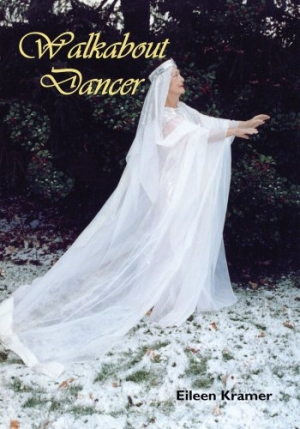Walkabout Dancer
It would be easy to dismiss the free-spirited imagery that adorns both the front and back covers of Eileen Kramer’s memoir, Walkabout Dancer, as silly or amateurish. Like comparable books with a choreography theme, however, its design aptly foreshadows the whimsical content that unfolds in between. Both the title and the kooky photographs will compel female kindred spirits to see what it’s about.
Australian-born Kramer is a captivating storyteller who marches to the sound of her own drummer as she dances her way across continents. The ups and downs of this seasoned dancer’s colorful life will resonate with anyone who has ever eschewed conventional thinking to pursue a nontraditional career in the performing arts.
Born in 1914 into an idyllic upbringing at Mosman Bay, Kramer’s parents recognized early that their intrepid little wild child was very much her own person who adored being the center of attention. Singing and dancing lessons fueled what would become her lifelong obsession with music. “At the age of nine or ten,” she writes, “I became a theatrical producer. Two items I cared about were: one, my ‘Dance of the Veils,’ performed to exotic music provided by my brother on his mouth organ; and two, ‘Bluebeard, a drama in one act.’”
A combination of curiosity and chutzpah underscores many of the decisions Kramer makes on the path to adulthood. A fascination with psychoanalysis compels her to make an appointment—“I was eager to learn more about myself”—with a doctor who subsequently becomes her first lover. On their first date, she recalls, “I felt like someone in a Noel Coward play, sitting in a deep, cozy couch, sipping a cocktail with an attractive older man in a smart hotel.”
In 1939, Kramer’s future bursts into clarity when (at age 25) she attends a Bodenwieser Dance Company performance and is bewitched by the dancers. Kramer describes the encounter in captivating style typical of her memoir. “The first one I took notice of was a dark bewitching creature such as I had never before seen. I was quite in awe of her,” she writes. “With her dark shiny eyelids and crimson lipstick she was from a distant world of glamorous, tigerish women I had only read about in novels.”
Kramer instantly decides she must be a part of this fabulous world and the next day seeks out Madame Gertrude Bodenwieser in order to audition. Upon her acceptance into the ballet company, Kramer is immersed in a globe-trotting journey over the next five decades that not only broadens her expertise in expressive choreography but also expands her awareness of diverse cultures throughout Europe, India, the United States, and South Africa. While Kramer’s name may not be as famous as some other choreographers, she was still designing productions and training dancers into her late 90s.
The book is replete with road-show anecdotes, including an incident in which costumes were lost in transit. Undaunted, Kramer improvised, creating new outfits without benefit of patterns or a sewing machine. She also relates with poignancy the deaths of beloved friends and mentors and says, “Although I have found fulfillment far away in West Virginia, I would like them to know that I am still a Bodenwieser dancer.”
The black-and-white photographs—a mix of candid pictures and professional performance shots—are a smart accompaniment to Kramer’s recollections about the Bodenwieser troupe and her work with the Trillium Performing Arts Collective (a community-based center for the performing arts in West Virginia). Along with this, the spiritual side of her personality emerges in reference to sacred places she visited in India and the Australian Outback.
Reviewed by
Christina Hamlett
Disclosure: This article is not an endorsement, but a review. The publisher of this book provided free copies of the book and paid a small fee to have their book reviewed by a professional reviewer. Foreword Reviews and Clarion Reviews make no guarantee that the publisher will receive a positive review. Foreword Magazine, Inc. is disclosing this in accordance with the Federal Trade Commission’s 16 CFR, Part 255.

